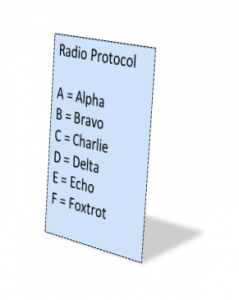A Vital Role in the Effectiveness of a CERT program
In a serious emergency where power is interrupted, landline telephones are often affected and even cell phones become unreliable due to central computer outage, damaged antennas and/or over usage by the populace.
So what is the answer for emergency communications for neighborhood CERT groups — to warn of dangers? Call for help for injured? Share news?

In an emergency use standard radio protocol
The answer for most teams becomes the two-way Family Radio Service . . . the inexpensive walkie-talkies that are used by campers, modelers, children at play and at a variety of club and athletic events.
The FRS/GMRS (Family Radio Service/Ground Mobile Radio Service) radios typically have 22 separate channels and the more elaborate ones have additional “privacy” settings on these channels that extend them into the hundreds of “channels.”
Two Classes of Radio for Local Neighborhood Groups
Simple Radios
We have equipped every one of our team members with a simple radio. (The team leaders, who have the need to communicate with other leaders, have more sophisticated radios with slightly longer range.) Regular team members in each Division or neighborhood of 50-75 homes only have the need to communicate within their Division — over distances of less than a mile.
Having a less-sophisticated radio is actually an advantage since one that is too “sensitive” is likely to pick up interference from outside the immediate neighborhood, where frequencies are open to all citizens.
Each of our Divisions has two designated frequencies (primary and backup) and we have special frequencies assigned to team leaders for coordinated efforts. This allows us to manage everything from Search & Rescue Operations to First Aid/Triage, Security and Logistics, etc.
The two brands we have found most satisfactory for our purposes are the Uniden and the Midland. These both perform well and have a variety of models. Our homes are close to one another and the six neighborhoods all fall within a relatively compact area so these units work well for us. You can get details on each of these on our walkie-talkie review page.
Radios with Wider Range
If your neighborhood/s and homes are spread out in suburban or rural areas, you may find it necessary to invest in more expensive units with greater range. We have tested all manner of these radios in a wide range of prices and “claimed” range of operation.
If the claims are accurate, they probably tested them on flat ground in deserted areas with little or no interference. From our perspective, all claims have to be treated as inflated! In other words, purchase several pairs and test them before you commit to a volume purchase.
In addition to the general communications, we have three licensed Amateur Radio Operators (HAM operators) on our team who are authorized (and equipped) to communicate with the emergency radio organization/s that work within our city and county. We also have a few Citizen Band (CB) Radios that have a somewhat greater range than our FRS/GMRS units.
Ongoing Emergency Communications Training
Radio Drills
We have monthly training drills on the radios and ongoing training for new team members.
You’d be surprised — or maybe you wouldn’t — at how easy it is for adults to forget exactly how to change channels and volume on a little radio that only has two buttons! Children seem to have no difficulty.
We follow a standard radio protocol in our communications and in a real emergency have specific people assigned to record the subjects of messages for a log.
Radio Batteries
We also schedule battery-replacements along with our drills — typically, twice a year when the time changes.
We prefer to use regular (not rechargeable) batteries since in an emergency there may be no recharge capability. After several rigorous tests, we have concluded that Energizer brand batteries generally last longer than any others.
As you can tell, we take our emergency communications very seriously. We recognize that in a real emergency, time is of the essence and good communications within the neighborhood are likely to save lives and preserve property.
This post is part of a series. Don’t miss a single one — sign up now to get them all automatically!
Don't miss a single Advisory.
Thank you for subscribing.
Something went wrong.
